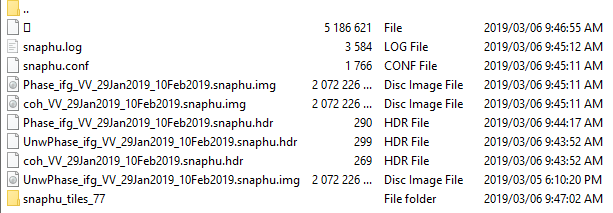I’ve added the pipeline for displacement calculation by combining your code and that of @johngan. Sharing it here for anyone who might find it useful.
import os
from snappy import GPF
from snappy import ProductIO
from snappy import HashMap
from snappy import jpy
from snappy import WKTReader
import subprocess
from time import *
import glob
"""https://forum.step.esa.int/t/slower-snappy-processing/6354/5"""
# Hashmap is used to give us access to all JAVA oerators
HashMap = jpy.get_type('java.util.HashMap')
parameters = HashMap()
def read(filename):
return ProductIO.readProduct(filename)
def write(product, filename):
ProductIO.writeProduct(product, filename, "BEAM-DIMAP")
def topsar_split(product):
parameters.put('subswath', 'IW2')
parameters.put('selectedPolarisations', 'VV')
return GPF.createProduct("TOPSAR-Split", parameters, product)
def apply_orbit_file(product):
parameters.put("Orbit State Vectors", "Sentinel Precise (Auto Download)")
parameters.put("Polynomial Degree", 3)
return GPF.createProduct("Apply-Orbit-File", parameters, product)
def back_geocoding(product):
parameters.put("Digital Elevation Model", "SRTM 1Sec HGT (Auto Download)")
parameters.put("DEM Resampling Method", "BICUBIC_INTERPOLATION")
parameters.put("Resampling Type", "BISINC_5_POINT_INTERPOLATION")
parameters.put("Mask out areas with no elevation", True)
parameters.put("Output Deramp and Demod Phase", False)
return GPF.createProduct("Back-Geocoding", parameters, product)
def interferogram(product):
parameters.put("Subtract flat-earth phase", True)
parameters.put("Degree of \"Flat Earth\" polynomial", 5)
parameters.put("Number of \"Flat Earth\" estimation points", 501)
parameters.put("Orbit interpolation degree", 3)
parameters.put("Include coherence estimation", True)
parameters.put("Square Pixel", False)
parameters.put("Independent Window Sizes", False)
parameters.put("Coherence Azimuth Window Size", 10)
parameters.put("Coherence Range Window Size", 10)
return GPF.createProduct("Interferogram", parameters, product)
def topsar_deburst(product):
parameters.put("Polarisations", "VV")
return GPF.createProduct("TOPSAR-Deburst", parameters, product)
def topophase_removal(product):
parameters.put("Orbit Interpolation Degree", 3)
parameters.put("Digital Elevation Model", "SRTM 1Sec HGT (Auto Download)")
parameters.put("Tile Extension[%]", 100)
parameters.put("Output topographic phase band", True)
parameters.put("Output elevation band", False)
return GPF.createProduct("TopoPhaseRemoval", parameters, product)
def goldstein_phasefiltering(product):
parameters.put("Adaptive Filter Exponent in(0,1]:", 1.0)
parameters.put("FFT Size", 64)
parameters.put("Window Size", 3)
parameters.put("Use coherence mask", False)
parameters.put("Coherence Threshold in[0,1]:", 0.2)
return GPF.createProduct("GoldsteinPhaseFiltering", parameters, product)
def create_subset(product):
"""obtain polygon with VERTEX"""
wkt = "POLYGON((4.3108 51.8655,4.416 51.8655,4.416 51.9163,4.3108 51.9163,4.3108 51.8655))"
geom = WKTReader().read(wkt)
parameters.put('copyMetadata', True)
parameters.put('geoRegion', geom)
return GPF.createProduct('Subset', parameters, product)
def unwrap_snaphu():
temp_path = os.path.join(path2zipfolder, 'snaphu_AT2')
product = os.path.join(path2zipfolder, 'results2.dim')
parameters = HashMap()
parameters_snaphu = HashMap()
parameters_snaphu.put("targetFolder", str(temp_path))
inputfile = ProductIO.readProduct(str(product))
result_SNE = GPF.createProduct("SnaphuExport", parameters_snaphu, inputfile)
ProductIO.writeProduct(result_SNE, temp_path, "Snaphu")
infile = os.path.join(temp_path, "snaphu.conf")
with open(str(infile)) as lines:
line = lines.readlines()[6]
snaphu_string = line[1:].strip()
snaphu_args = snaphu_string.split()
process = subprocess.Popen(snaphu_args, cwd=str(temp_path))
process.communicate()
process.wait()
print('done')
unwrapped_list = glob.glob(str(temp_path) + "/UnwPhase*.hdr")
unwrapped_hdr = str(unwrapped_list[0])
unwrapped_read = ProductIO.readProduct(unwrapped_hdr)
fn = os.path.join(temp_path, "unwrapped_read.dim")
ProductIO.writeProduct(unwrapped_read, fn, "BEAM-DIMAP")
unwrapped = ProductIO.readProduct(fn)
snaphu_files = jpy.array('org.esa.snap.core.datamodel.Product', 2)
snaphu_files[0] = inputfile
snaphu_files[1] = unwrapped
result_SI = GPF.createProduct("SnaphuImport", parameters, snaphu_files)
result_PD = GPF.createProduct("PhaseToDisplacement", parameters, result_SI)
outpath = os.path.join(path2zipfolder, 'DisplacementVert')
ProductIO.writeProduct(result_PD, outpath, "BEAM-DIMAP")
def insar_pipeline(filename_1, filename_2):
print('Reading SAR data')
product_1 = read(filename_1)
product_2 = read(filename_2)
print('TOPSAR-Split')
product_TOPSAR_1 = topsar_split(product_1)
product_TOPSAR_2 = topsar_split(product_2)
print('Applying precise orbit files')
product_orbitFile_1 = apply_orbit_file(product_TOPSAR_1)
product_orbitFile_2 = apply_orbit_file(product_TOPSAR_2)
print('back geocoding')
backGeocoding = back_geocoding([product_orbitFile_1, product_orbitFile_2])
print('inerferogram generation')
interferogram_formation = interferogram(backGeocoding)
print('TOPSAR_deburst')
TOPSAR_deburst = topsar_deburst(interferogram_formation)
print('TopoPhase removal')
TOPO_phase_removal =topophase_removal(TOPSAR_deburst)
print('Goldstein filtering')
Goldstein_phasefiltering = goldstein_phasefiltering(TOPO_phase_removal)
print('Create subset')
Subset = create_subset(Goldstein_phasefiltering)
print('Writing final wrapped product')
path2zipfolder = os.path.abspath(os.path.join(os.path.dirname(__file__), '..'))
fp_out = os.path.join(path2zipfolder,'results2')
write(Subset, fp_out)
print('Snaphu unwrapping')
unwrap_snaphu()
path2zipfolder = os.path.abspath(os.path.join(os.path.dirname(__file__), '..'))
fn1 = os.path.join(path2zipfolder, 'S1A_IW_SLC__1SDV_20150402T173247_20150402T173314_005308_006B81_76C8.zip')
fn2 = os.path.join(path2zipfolder, 'S1A_IW_SLC__1SDV_20150601T173250_20150601T173317_006183_0080D8_1DFD.zip')
insar_pipeline(fn1, fn2)

